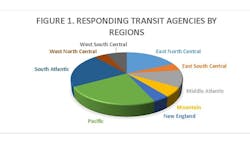Research Managed by Urban Transportation Center at UIC Designed to Help Mitigate Impact of Weather on Transit Systems
Transit agency professionals have a moderate-to-high level of confidence that the systems they manage will continue to operate during an extreme weather event, while acknowledging that extreme weather incidents are happening more often and becoming more severe.
And, case studies of two transit agencies revealed: 1) Commuters use below grade rapid transit stations more often during heavy rain or snow than above-ground stations. 2) Installation of shelters and benches at bus stops or on subway platforms helps maintain ridership on extreme weather days, and may even cut down on ridership loss during extreme weather events.
These are among the conclusions reached by researchers studying the impact of severe weather on public transit systems. Two separate reports were prepared and managed by the Urban Transportation Center at the University of Illinois at Chicago, with support from researchers at Arizona State University.
Here are capsule accounts from each report:
National Survey of US Public Transit Agency Experience with and Response to Extreme Weather Events
Approximately 900 transit professionals in the areas of planning, operation, maintenance, and engineering participated in a survey, which reached 273 U.S. transit agencies. The survey was conducted in June of 2016.
The goal of the project was to better comprehend the types of extreme weather impacting transit agencies, risks and response and preparation. As noted in the report: “While many transit agencies have long experience coping with weather disruptions, they are confronted with the new challenge of identifying and developing appropriate long-term adaptation strategies to address greater risk and uncertainty associated with extreme weather.”
Some findings include:
· Rainstorms and thunderstorms are the most frequent extreme weather event facing transit agencies, followed by extreme cold, high winds and heat.
· Large snowfalls have caused the most disruption, and floods were cited as having the second greatest impact.
· The fallout from extreme weather includes significant delays, temporary shutdowns and damage to trains, buses and equipment.
Decision Analysis to Address Extreme Weather: Extreme Weather Effects on Ridership and Modeling the Decision to Invest in Canopy Coverage
The goal of this report was to quantify and assess canopy investment options at services areas for the Chicago Transit Authority (CTA) and Utah Transit Authority (UTA). The CTA case focused on rail transit station coverage and the UTA analysis focused on bus stop canopy coverage.
· The results demonstrate how selection among different types of station coverage infrastructure may mitigate the loss of ridership driven by extreme weather.
· Researchers maintain the findings will provide an initial decision tool to better guide transit agencies on making capital improvement decisions related to extreme weather effects on transit.
UTC Director Dr. P.S. Sriraj served as principal investigator on both reports, which were funded by the Center for Urban Transportation Research at the University of South Florida.
Here’s how you can learn more about the recent UTC research on severe weather:
· Read an abstract and get access to the complete report on the national survey of public transit officials.
· Read an abstract and get access to the complete report on the effects of extreme weather on ridership.
The Urban Transportation Center at UIC is dedicated to conducting research and education and providing technical assistance on urban transportation planning, policy, operations, and management. The UTC is part of the College of Urban Planning and Public Affairs, a nationally-recognized innovator in education, research, and engagement in support of the nation’s cities and metropolitan areas. Learn more by visiting www.utc.uic.edu.


